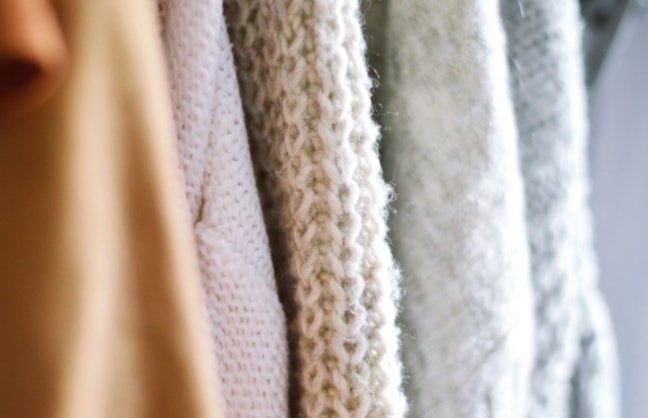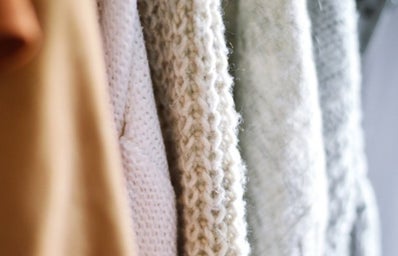Undoubtedly no artform is as woven into our daily lives as Textiles, and yet rarely is it appreciated for its political feminist power: as a radical intersectional artform with the ability to strengthen community identity. Therefore, in this article I wish to interrogate the devaluing of Textiles as a mere craft economy, deemed inferior to Fine Arts – and point the finger at the undeniable stain of misogyny in the arts.
Yet before lunging into such broad ideas…
There seems to be some confusion about what constitutes ‘Textiles’, as it borders the art realms of craft/design and fine art. For some it evokes images of haute couture, and others kitschy Granny’s knitting. Yet the reality is much more diverse. Anything from decorative woven baskets and fluffy yeti boots to epic historical works such as the Unicorn Tapestries hung in The MET Museum, fit beneath the metaphorical textile umbrella (or parasol). Consequently, wide variety amongst the label ‘textile’ makes distinguishing the artform’s history an arduous task. Exact dates are impossible to determine (due to the fast degradation of fabrics), yet it is suggested that human beings began utilising textiles between 70 and 85 thousand years ago, by adorning furs and pelts. However, knowledge of textile histories is limited to access to existing historical textiles, such as tapestries, rugs, and historical clothing. It is undoubtable however that textiles thread the fabric of our society and represent our consciousness as unique individuals: communicating our social status, beliefs, and personality. Yet above all, they provide us with the essentials for survival, such as heat, comfort, or just plain and simple beauty.
So why should we care that Textiles are undervalued?
Unlike other craft-based arts specialisations such as metal and wood working, textiles continue to be diminished as a hobby and the complex techniques involved in the production of textiles are conveniently dismissed. The difference? Gender splits between these artforms.
The association of textiles with clothing and domesticity has reduced its reputation to those who primarily make it: women. Historically, women attempting to pierce the male, art world bubble were forced to do so through ‘women’s disciplines’ like fashion and textiles, seen with the iconic Anni Albers. Yet once mastering such specialisations, the response was one of dismissal, disdain, and condescension. Textiles were viewed as a lower brow ‘women’s art’ and perhaps still are. Yet diminishing all textiles to hobby/craft work ignores the traditional practice of textiles amongst indigenous communities to build identity and create societal cohesion. Kilts of Scotland provide examples of constructed identity, as unique family tartan patterns were produced and adorned to represent family identity and communicate their status. In the Native American, Navajo Communities, rug weaving was also a cultural tradition inherited between generations with geometric patterns and symbols to represent their lives. The dismissal of textiles not only belittles women’s creative power but erases the cultural heritage of indigenous communities.
Textile artworks are often displayed as decorative and homemade regardless of their emotional depth and intentionality, compared to other male dominated craft disciplines. However, this disregards the immense talent and practice required to learn textile making techniques. Often such practices are inherited through communities. The traditional hand lace makers of the UK embody such a claim, as they produce some of the most gorgeously lavish lace with a technique so complex that years or decades of specialised training are required to master it. Not to mention the technical ability it takes to produce threads involved and weave it into designs. Consequently, it has become a dying practice, shared and passed on within small communities. Any denial that such textile practices mirror the rigor of other male dominated artforms feels ludicrous. From an intersectional standpoint, it also fails to acknowledge the power of lived experience and shared community in producing textiles. Indigenous communities collaboratively produce movements, styles, symbols of a shared identity that becomes art. While this may not fit the euro-centric patriarchal vision of high art, it remains just as powerful if not more so.
In the face of patronising attitudes towards textiles as an artform, the response of artists is to reclaim the power of textiles to form community empowerment amongst women artists. Creating safe radical spaces that critique the white male dominated world of the arts and produce intersectional discourse on how arts disciplines are valued, and by whom. Galleries are beginning to publicly acknowledge women textile artists, such as the Tate Modern which has recently displayed work by Magdalena Abakanowicz and Anni Albers. Other Galleries such as the Hayward Gallery displayed Louise Bourgeois’ vast feminist textile collections and smaller galleries, such as TJ Boulting, featured breathtakingly animated pieces by Daisy Collingridge. It does not go unnoticed however that such examples are few and far between… and dominated by white women.
With beauty and utility, textiles are unbelievably valuable in their versatility. A life without textiles would not presently exist. Therefore, it seems that the reputation of textiles and those who produce them are strengthening as more public exhibitions in major galleries arise. Still Textile artists remain largely unrecognized, underpaid and courses teaching coming generations the techniques and skill sets of such artists are being cut from curriculums. So, progress in establishing the textile artform in the wider art world continues sluggishly. As women continually break through the pretentious belittling barriers of art’s high society, misogynistic attitudes towards textiles will have no choice but to unravel, and I wish to quicken that process by whatever means possible.


